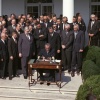In 1789, with the War of Independence well behind them and the prodigious task of writing a constitution for the new United States of America also completed, the Founding Fathers turned their attention to the individual rights of the citizenry. Thomas Jefferson, in particular, thought that the constitution was incomplete for failing to address the primary freedom of religion. Following the successful passage of his Bill of Religious Freedom in the Virginia Legislature, he brought the issue before the larger Constitutional Convention. With James Madison’s sponsorship, the first of ten amendments were written into the constitution to protect what he called our “indispensable democratic freedoms.”
Transaction Publishers has released a new edition of Professor Milton Konvitz’s classic history of First Amendment rights under the United States Constitution, Fundamental Liberties of a Free People, featuring a new introduction and a new afterward by the author.
There can be no question that a full understanding of the most basic American liberties and their history is essential to any modern political or legal discussion of human rights. In this 1957 classic, Professor Konvitz does the near impossible: He makes the complexities of historical legal wranglings accessible to a secular readership.
Professor Konvitz, Professor Emeritus of Law and Industrial Relations at Cornell University, examines the legal and historical evolution of our modern freedoms of religion, speech, press, and assembly. Fundamental Liberties of a Free People effectively enunciates the hard fought battles over the interpretive nuances of the mere forty-five words that constitute the First Amendment to the United States Constitution.
What becomes quickly apparent from Professor Konvitz’s elucidations of the component liberties of the First Amendment is how good it is to have so much to haggle over. For instance, in part one, which focuses on freedom of religion, Professor Konvitz is careful to discuss both the principle of separation of church and state (“Congress shall make no law respecting an establishment of religion, …”) along with the free exercise of religion, the issue so dear to Jefferson and Madison (“… or prohibiting the free exercise thereof”).
The importance of this latter clause cannot be overstated, as it explicitly recognizes a human liberty so basic and yet so denied to so many throughout the course of history. Thus, even the “humbug” religion of the “I Am” movement as described in the seminal Ballard case of 1945 must be protected. Basic, of course, but magnificent nevertheless because it implicitly recognizes that the law among humans must be subordinate to the relationship of God and humans (although whatever or whoever God may be remains unspecified). Citizens of the United States are therefore fortunate for “in the United States, every church is a free church.”
Also in part one is an excellent short history of religious freedoms leading up to the events of the 1789 Constitutional Convention.
In part two, Professor Konvitz turns his attention to the combined freedoms of speech, press, and assembly. Here he examines the fine gradations of understanding when those rights of expression are exercised in public life. Familiar issues such as fighting words, obscenity, and picketing are examined in legal context in their own chapters. The longest chapter is reserved for “The Right to Be Let Alone,” which is a compelling discussion of privacy and slander. Never before had I considered this right to be quite so paramount as when I read the opening sentence of this chapter quoting Justice Douglas thus: “The right to be let alone is indeed the beginning of all freedom.” Quite a wake up call.
The book’s third part addresses the Clear and Present Danger Doctrine’s limitations to the freedoms of expression. These necessary abridgements to these freedoms seem to have found first champion in, of all people, Thomas Jefferson. In the Virginia Statute of Religious Freedom, Jefferson, its drafter, both established the freedom of religion in Virginia while simultaneously reserving the right for the officers of civil government to “interfere when principles break out into overt acts against peace and good order.” This part dedicates much attention to one seminal case, Dennis v. the United States (in which statements made by Communists regarding the overthrow of the government were at issue), and illustrates how even the treasured freedom of speech is not without parameters.
The fundamental thrust of the book is thus very well established. Unfortunately, Professor Konvitz’s new introduction and afterward may well raise eyebrows for his blatant display of ideological partisanship. For instance, in the new introduction, he admonishes that “Americans must be vigilant that their constitutional ideology (i.e., of Justice Clarence Thomas and Justice Antonin Scalia) does not win out in the end.” It looks like we are off to a bad start.
Professor Konvitz’s excoriation of Justice Scalia unfortunately finds place in the concluding sentence of his afterward as well when he decries that “Justice Scalia … may rightly be cited as a classic case of conservative judicial activism, alongside the notorious Lochner case of 1905.”
The Lochner case of 1905 was the one in which the Supreme Court held as unconstitutional the New York Bakeshop Act, which limited the legal hours of labor per day. Professor Konvitz considers it “notorious” because “… the only ones who felt adversely affected were the owners of the bakeries.” The only ones? Have property rights become some unimportant category? Professor Konvitz seems to think so.
Elsewhere, a parenthetical aside is directed at Justice James Clark McReynolds, characterizing him as a staunch constitutional conservative and then referring to his “rude ness and his openly shown anti-Semitism.” True or not, it is hard not to think that comment unnecessary.
Finally, he makes the exact nuance of his ideology clear in the last paragraph of his introduction by asserting that “a static tradition may satisfy the believers in a static religion, but it has no place in a living constitution.” With those final two words of that sentence, Professor Konvitz essentially issues fair warning to those who do not subscribe to the modern definition of a living constitution as one that adapts to a society’s ever-changing standards.
In the end, I may disagree with Professor Konvitz over his ideology and certainly over his opinion of Justice Antonin Scalia, but we share a common interest in the promotion of liberty. Fundamental Liberties of a Free People effectively reminds us how important the existence of First Amendment rights are to the promotion of personal freedom in the United States. This work is also a necessary reminder of the tremendous legacy bestowed to all citizens of the United States by the Founding Fathers and many others over the course of American history. Such is the enormity of this heritage that liberals of both classical and modern convention cannot fail to appreciate it.
Perhaps the most poignant quote from this book speaks directly to the American moral tradition: “Religious leaders … want the American people to live in a moral and spiritual atmosphere which will give them the wisdom and the will not to be satisfied with mere bigness but to seek greatness.” Combined with the totality of arguments enunciated to define the articulated freedoms in the United States, one cannot help but ponder the profound and unique character of liberty in the United States of America.











